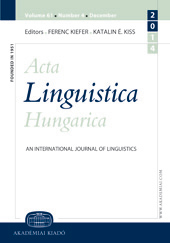Grammaticalisation and preverbs
Grammaticalisation and preverbs
Author(s): Tamás ForgácsSubject(s): Morphology
Published by: Akadémiai Kiadó
Keywords: Hungarian; grammaticalisation; preverbs; productivity; centre vs. periphery;
Summary/Abstract: The aim of this paper is to investigate the historical process whereby preverbs came into being in Hungarian: to shed light on the reason why certain adverbial elements, used autonomously at first, were subsequently degraded into items of a bound grammatical category. It will be seen that that path is anything but straight: various factors may be involved in adverbial modifiers turning into preverbs, diverse “access roads” may lead to the same main road (this is also part of the reason why a number of items in the present-day stock of Hungarian preverbs are related to several parts of speech, e.g., to adverbs and to postpositions, at the same time). The second part of the paper tries to answer the questions why the stock of preverbs is presented in a heterogeneous manner in certain grammars of Hungarian, what role subjective criteria play in classifications, and how reliable the criterion of productivity is as a general guiding principle.
Journal: Acta Linguistica Hungarica (Since 2017 Acta Linguistica Academica)
- Issue Year: 51/2004
- Issue No: 1-2
- Page Range: 45-84
- Page Count: 40
- Language: English

